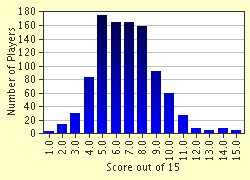Quiz Answer Key and Fun Facts
1. The current White House is not the original. What happened to the original White House?
2. How many legal executions took place in the United States between 1976 and October 2000?
3. What was America named after?
4. Name the massacre that occurred in Vietnam on March 16, 1968 that added great impetus to the movement to end US involvement?
5. During WWII, the United States rounded up virtually all Japanese-Americans and relocated them to internment camps. When did the internment of Japanese-Americans finally end?
6. What is the lowest estimated number of people killed outright or shortly after the Enola Gay dropped her payload onto Hiroshima?
7. Who repulsed the American threat of invasion in the War of 1812?
8. Which of the following Founding Fathers of the United States of America kept slaves on his estate at Montpelier, despite helping to frame the Bill of Rights and speaking out against the sectional controversy splitting the Union?
9. What was the name of the movement that helped runaway Southern slaves escape to freedom in Canada?
10. On December 29, 1890, what massacre of Native-Americans occurred?
11. A number of U.S. Presidents have died while in office. What did the SECOND President to die during his term of office die from?
12. Which surname in the United States military forces suffered the highest number of casualties in the Vietnam War?
13. As of the most recent U.S. survey in 1990, what is the average percentage of the population by distribution across the entire United States that is Native-American?
14. Who was the only U.S. President to be married in the White House?
15. Before Benedict Arnold betrayed the United States by revealing the plans of a proposed American invasion of Canada, what rank did he attain in fighting for the United States in the War of Independence?
Source: Author
TemplarLLM
This quiz was reviewed by FunTrivia editor
bloomsby before going online.
Any errors found in FunTrivia content are routinely corrected through our feedback system.


